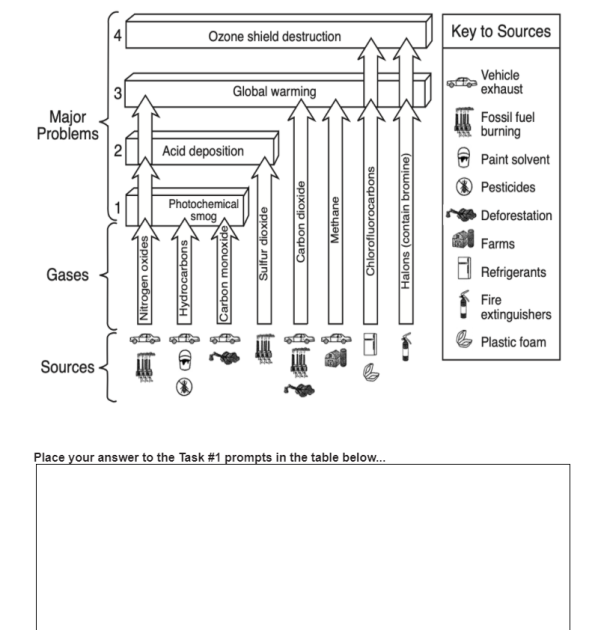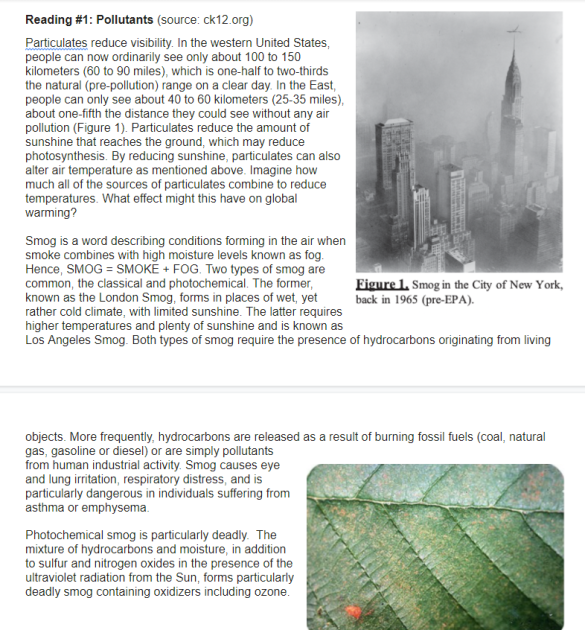Record the number of your two problems in your written response Identify a gas that contributes to the problems you selected State one way in which the amount of this gas can be reduced.
Record the number of your two problems in your written response Identify a gas that contributes to the problems you selected State one way in which the amount of this gas can be reduced.
Biochemistry
6th Edition
ISBN:9781305577206
Author:Reginald H. Garrett, Charles M. Grisham
Publisher:Reginald H. Garrett, Charles M. Grisham
Chapter17: Metabolism: An Overview
Section: Chapter Questions
Problem 16P
Related questions
Question
TASK #1: Please refer to the diagram on the next page as well as the text above.
Part A: Select two or more of the four major problems from the diagram (labeled as ‘1’, ‘2’, ‘3’ or ‘4’)
- Record the number of your two problems in your written response
- Identify a gas that contributes to the problems you selected
- State one way in which the amount of this gas can be reduced.
Part B: Explain why damage to the ozone shield is considered a threat to many organisms.

Transcribed Image Text:Ozone shield destruction
Key to Sources
Vehicle
'exhaust
Global warming
Major
Problems
Fossil fuel
burning
Acid deposition
Paint solvent
Pesticides
Photochemical
smog
Deforestation
Farms
Gases
Refrigerants
Fire
extinguishers
Plastic foam
Sources
Place your answer to the Task #1 prompts in the table below.
2.
3,
seppxo ueboUN
Hydrocarbons
Carbon monoxide
Sulfur dioxide
Carbon dioxide
Methane
Chlorofluorocarbons
Halons (contain bromine)

Transcribed Image Text:Reading #1: Pollutants (source: ck12.org)
Particulates reduce visibility. In the western United States,
people can now ordinarily see only about 100 to 150
kilometers (60 to 90 miles), which is one-half to two-thirds
the natural (pre-pollution) range on a clear day. In the East,
people can only see about 40 to 60 kilometers (25-35 miles),
about one-fifth the distance they could see without any air
pollution (Figure 1). Particulates reduce the amount of
sunshine that reaches the ground, which may reduce
photosynthesis. By reducing sunshine, particulates can also
alter air temperature as mentioned above. Imagine how
much all of the sources of particulates combine to reduce
temperatures. What effect might this have on global
warming?
Smog is a word describing conditions forming in the air when
smoke combines with high moisture levels known as fog.
Hence, SMOG = SMOKE + FOG. Two types of smog are
common, the classical and photochemical. The former,
known as the London Smog, forms in places of wet, yet
rather cold climate, with limited sunshine. The latter requires
higher temperatures and plenty of sunshine and is known as
Los Angeles Smog. Both types of smog require the presence of hydrocarbons originating from living
Figure 1. Smog in the City of New York,
back in 1965 (pre-EPA).
objects. More frequently, hydrocarbons are released as a result of burning fossil fuels (coal, natural
gas, gasoline or diesel) or are simply pollutants
from human industrial activity. Smog causes eye
and lung irritation, respiratory distress, and is
particularly dangerous in individuals suffering from
asthma or emphysema.
Photochemical smog is particularly deadly. The
mixture of hydrocarbons and moisture, in addition
to sulfur and nitrogen oxides in the presence of the
ultraviolet radiation from the Sun, forms particularly
deadly smog containing oxidizers including ozone.
Expert Solution
This question has been solved!
Explore an expertly crafted, step-by-step solution for a thorough understanding of key concepts.
This is a popular solution!
Trending now
This is a popular solution!
Step by step
Solved in 3 steps

Knowledge Booster
Learn more about
Need a deep-dive on the concept behind this application? Look no further. Learn more about this topic, biology and related others by exploring similar questions and additional content below.Recommended textbooks for you

Biochemistry
Biochemistry
ISBN:
9781305577206
Author:
Reginald H. Garrett, Charles M. Grisham
Publisher:
Cengage Learning

Biology: The Unity and Diversity of Life (MindTap…
Biology
ISBN:
9781305073951
Author:
Cecie Starr, Ralph Taggart, Christine Evers, Lisa Starr
Publisher:
Cengage Learning

Biology 2e
Biology
ISBN:
9781947172517
Author:
Matthew Douglas, Jung Choi, Mary Ann Clark
Publisher:
OpenStax

Biochemistry
Biochemistry
ISBN:
9781305577206
Author:
Reginald H. Garrett, Charles M. Grisham
Publisher:
Cengage Learning

Biology: The Unity and Diversity of Life (MindTap…
Biology
ISBN:
9781305073951
Author:
Cecie Starr, Ralph Taggart, Christine Evers, Lisa Starr
Publisher:
Cengage Learning

Biology 2e
Biology
ISBN:
9781947172517
Author:
Matthew Douglas, Jung Choi, Mary Ann Clark
Publisher:
OpenStax

Biology: The Unity and Diversity of Life (MindTap…
Biology
ISBN:
9781337408332
Author:
Cecie Starr, Ralph Taggart, Christine Evers, Lisa Starr
Publisher:
Cengage Learning


Biology Today and Tomorrow without Physiology (Mi…
Biology
ISBN:
9781305117396
Author:
Cecie Starr, Christine Evers, Lisa Starr
Publisher:
Cengage Learning